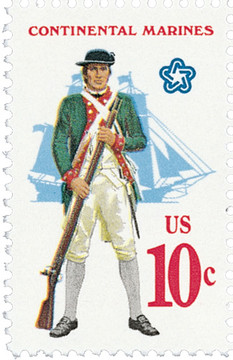
U.S. #1565
1975 10¢ Continental Army
Bicentennial Military Services
Issue Date: July 4, 1975
City: Washington, DC
Quantity: 44,963,750
Printed By: Bureau of Engraving and Printing
Printing Method: Photogravure
Perforations: 11
Color: Multicolored
Continental Army Formed
On June 14, 1775, the Second Continental Congress established the Continental Army, the precursor of the United States Army.
Prior to the American Revolutionary War, the colonies had their own militias composed of citizen-soldiers. And during larger threats, such as the French and Indian War (1754-63), they created temporary provincial regiments.
By the 1770s, relations with Britain began to deteriorate, and the colonists started to form militias for a possible war. After Britain passed the Intolerable Acts in 1774 to punish Massachusetts for the Boston Tea Party, many of the militias stepped up their training. In the fall of 1774, Richard Henry Lee was among several colonists to call for the creation of a national militia, but the First Continental Congress rejected the idea.
The following spring, as tensions continued to rise, the Massachusetts Provincial Congress created its own colonial army of 26 company regiments on April 23. Other colonies soon followed, including New Hampshire, Rhode Island, and Connecticut.
That June, the Massachusetts Congress addressed the Second Continental Congress and requested that they take over authority of the colonial army. With support from John Adams among others, the Second Continental Congress agreed to take command of the Boston troops. They also recognized the need for greater defense and passed a resolution creating the Continental Army. This included appropriating $2 million in support of the troops around Boston and New York City. Congress also authorized the creation of 10 companies of expert riflemen (who later became known as the 1st Continental Regiment) from Pennsylvania, Maryland, and Virginia, who were sent to Boston to support the militia there. The following day, the Continental Congress unanimously elected George Washington Commander-in-Chief of the Continental Army.
About a month later, Congress asked all the colonies to form their own militia companies from “all able bodied effective men, between sixteen and fifty years of age.” Congress, as well as many colonists, didn’t want a standing army, but they also needed to have the discipline to face an organized British force. Enlistment periods ranged from one to three years. Over the course of the war, the units were dissolved and reorganized several times. Reportedly, the Continental Army never contained more than 17,000 men at one time. It was, however, a racially integrated army in which African American slaves were promised their freedom after their military service. African Americans made up about one-fifth of the Continental Army in the north. (This was the last time the U.S. army was fully integrated until the Korean War.)
The Continental Army began its service in Massachusetts, but moved on to New York following the evacuation of Boston. They spent the next five years battling the British in New York, New Jersey, and Pennsylvania at such notable battles as Trenton, Princeton, Brandywine, and Germantown.
Because it was such a young military force, the Continental Army was plagued with issues from the beginning, including poor planning and training, short enlistments, and rivalries between the states. While patriotism drove early recruits, incentives were needed to convince men to join later in the war. However, the leadership of George Washington and other officers helped to keep the army together and learn from mistakes with each battle.
After the war ended with the Treaty of Paris, the Continental Army was largely disbanded in 1783. It would be over 10 years before America created its permanent Army, which you can read more about here.
The Bicentennial Series
The U.S. Bicentennial was a series of celebrations during the mid-1970s that commemorated the historic events leading to America’s independence from Great Britain. The official events began on April 1, 1975, when the American Freedom Train departed Delaware to begin a 21-month, 25,338-mile tour of the 48 contiguous states. For more than a year, a wave of patriotism swept the nation as elaborate firework displays lit up skies across the U.S., an international fleet of tall-mast sailing ships gathered in New York City and Boston, and Queen Elizabeth made a state visit. The celebration culminated on July 4, 1976, with the 200th anniversary of the adoption of the Declaration of Independence.
The U.S.P.S. issued 113 commemorative stamps over a six-year period in honor of the U.S. bicentennial, beginning with the American Revolution Bicentennial Commission Emblem stamp (U.S. #1432). As a group, the Bicentennial Series chronicles one of our nation’s most important chapters, and remembers the events and patriots who made the U.S. a world model for liberty.

















